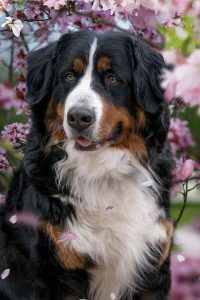The Border Collie and Bernese Mountain Dog were bred together to produce the charming hybrid breed called the Bordernese. This dog is of medium to large size and showcases the Border Collie’s beautiful fur and color, combined with the Bernese’s striking coat and sturdy physique. The Bordernese possesses a remarkable blend of intelligence and gentleness, making it an ideal companion. Its friendly nature and adaptable temperament make it particularly well-suited for households with young children or other furry companions.
Characteristics of a Bordernese
The Bordernese, a delightful mix of the Bernese Mountain Dog and the Border Collie, brings together the finest qualities from both breeds. This hybrid breed successfully combines the Border Collie’s remarkable energy and unwavering work ethic with the Bernese’s calm and easygoing temperament. As a result, the Bordernese is an adaptable companion capable of tackling a full day’s work and also knowing how to unwind and enjoy leisure time.
These dogs are highly regarded for their exceptional friendliness and amiability. While their natural inclination is towards humans, they may not excel in guarding possessions. However, their friendly nature might deter a potential intruder from making off with the TV remote!
| Attribute | Range |
| Stature | 56cm to 76cm |
| Mass | 18kg to 41kg |
| Longevity | Up to 15 years |
| Coat Colors | White, black, chestnut |
| Ideal for | Active households, individuals seeking a moderately energetic canine companion |
| Disposition | Guarding, loving, kind-hearted, clever, sociable |
Bordernese Breed History

The Bordernese, being a relatively young and hybrid breed, lacks a well-documented history. However, we have valuable information about its parent breeds, the Border Collie and the Bernese Mountain Dog.
The Border Collie is widely recognized as one of the most intelligent dog breeds in the world. Bred as autonomous herders, they have always exhibited exceptional intelligence and agility. Originating as farm dogs in the border region between Scotland and England, Border Collies proved invaluable in their herding abilities. Over time, their popularity grew, capturing the attention of notable figures such as Queen Victoria. Formal recognition by the AKC was granted in 1995, solidifying their reputation for intelligence, determination, and grace.
In contrast, the Bernese Mountain Dog possesses a laid-back and easy-going temperament while exuding power and beauty. This breed emerged as a farm dog in the Alpine Mountains of Switzerland in the early 20th century. They were proficient in herding cattle, providing security with their robust barks, and even pulling milk carts with their strong muscles.
Appearance
In terms of appearance, the Bordernese can resemble either parent breed in terms of their physique. They may inherit the large and sturdy build of the Bernese or the more compact and agile frame of the Border Collie. As a result, the size of the Bordernese can vary. However, the long and thick fur is a consistent feature, as both parent breeds share a similar fur type.
The Bordernese is often characterized by its floppy ears and striking dark brown eyes, which are set atop a powerful nose. These distinctive features contribute to the overall appeal of this hybrid breed.
Size, Height & Weight
The hybrid of a Bernese Mountain Dog and a Border Collie typically weighs between forty to eighty pounds. This weight range is noticeably lower than that of a purebred Bernese Mountain Dog, which often exceeds a hundred pounds.
In terms of height, a Bernese Mountain Dog and Border Collie mix typically measures under 28 inches at the withers. These measurements provide a rough idea of the average size and proportions commonly observed in this mixed breed.
Coats & Colors
The Bernese Mountain Dog and Border Collie mix typically possesses a long and thick coat, reminiscent of the Bernese Mountain Dog. In terms of color, this type of mix often showcases shades of brown or black, with a notable presence of white markings compared to other Bernese Mountain Dog mixes.
These white markings create a striking contrast against the darker fur, contributing to the breed’s distinctive and captivating appearance as a whole.
Personality & Temperament of a Bordernese
The Bordernese dogs have a unique and endearing personality. They make wonderful family pets due to their loyalty, affection, and adaptability. These dogs thrive in the company of people and enjoy participating in family activities.
While they may initially exhibit shyness towards strangers, proper training and socialization can help them become more comfortable and confident in new situations. One remarkable quality of the Bordernese is their intelligence, which allows them to quickly grasp new concepts.
Intelligence
The Bordernese breed stands out for its unique combination of intelligence and an easy-going, cooperative attitude, distinguishing it from highly intelligent dogs that may pose challenges for their owners.
Bordernese dogs are highly intelligent, but they don’t typically seek to constantly challenge authority or seek stimulation. Instead, they prioritize making their human companions happy out of a deep desire to please.
Energy
The Bordernese’s high activity level makes it an ideal canine companion for active individuals who enjoy outdoor pursuits such as running or hiking. This breed thoroughly enjoys engagements in various outdoor activities and thrives on physical exercise. The Bordernese is adaptable and can thrive in different living environments, whether it be in urban or rural areas, as long as its exercise needs are met.
Family & Kids
Bordernese dogs are widely recognized as excellent family companions due to their patience and kindness towards young children. They have a natural ability to interact gently with small children, while also being playful and energetic with older children. Their adaptability makes them well-suited for families with children of various ages.
The calm and well-behaved temperament of Bordernese dogs makes them a great addition to any household. They are unlikely to cause chaos by racing through the house or accidentally knocking someone over, providing a sense of peace and tranquility. Their disposition and flexibility allow children to easily connect with their furry friend in a peaceful environment.
Other Animals
Bordernese dogs are well-known for their stable temperament and ability to get along with other animals. However, early socialization and obedience training are crucial to promote positive and harmonious interactions while minimizing potential issues. It is important to remember that individual personalities and life experiences can vary, so careful introductions and supervision of interactions are still necessary.
Bordernese dogs have a strong need for companionship and may not enjoy spending extended periods alone. Having a canine companion can help fulfill their social needs, as they thrive in the company of other dogs.
Strangers
Bordernese dogs are generally friendly towards outsiders, and while they are typically protective of their families, they may not excel as guard dogs. They tend to display a cordial and kind demeanor towards strangers.
However, they possess perceptiveness and awareness of their surroundings. Although they may not possess strong guarding instincts, Bordernese dogs often have a tendency to bark when they observe anything unusual or suspicious.
Do Bordernese Bark A Lot?
Bordernese dogs, with their watchful and alert nature, can indeed make good watchdogs. They have a tendency to bark when they detect something unusual or potential intruders. If you are looking for a loyal companion that can also alert you to suspicious activities, the Bordernese is an excellent choice.
Are Bordernese Good For Newbie Dog Owners?
Owning a Bordernese does not require a significant amount of prior dog-owning experience. These dogs thrive on spending quality time with their families and are known to be relatively easy to train. Their strong desire to please their owners and their close bond with them contribute to their trainability. This goes to show that the Bordernese is a great choice for anyone seeking a devoted and obedient companion due to their trainable nature and their affection for family time.
Training & Exercise
Being a responsible owner involves recognizing the importance of obedience training for your Bordernese. Bernese Mountain Dog and Border Collie mixes are intelligent and responsive to positive reinforcement training techniques.
Enrolling your Bordernese puppy in a puppy socialization class soon after bringing them home is highly recommended. These classes provide valuable opportunities for your puppy to interact with other dogs and develop essential social skills, including bite inhibition.
It is also beneficial to enroll your adult Bernese Mountain Dog/Border Collie mix in a basic obedience course. This allows you to reinforce previous training, promote good behavior, and establish a solid foundation for future learning.
Taking Care & Maintenance
The Bordernese breed is generally low maintenance when it comes to grooming, despite their larger size. While they do shed regularly throughout the year, managing their coat and minimizing shedding can usually be achieved with a few weekly brushing sessions. Regular brushing helps remove loose hair and prevents it from accumulating around the house.
Health of a Bordernese
Both Border Collies and Bernese Mountain Dogs have known hereditary health conditions that can affect their well-being. However, mixed breed dogs like the Bordernese often enjoy better overall health compared to their purebred counterparts. This is primarily due to their larger gene pool, which can help reduce the likelihood of inheriting specific genetic diseases.
Diet & Nutrition
To ensure the overall health and well-being of your Bordernese, providing them with a high-quality diet is essential. Go with reputable dog food brand that focuses on whole food sources and avoids products that may contain artificial additives or allergens. Choosing ingredients of high quality can help provide a balanced diet for your pet. If you are considering a homemade or raw diet for your Bordernese, it is strongly recommended that you consult with your veterinarian first.
On average, a Bordernese may consume around 3.5 cups of premium dog food per day. It is beneficial to divide this quantity into multiple feedings throughout the day to promote digestion and prevent overeating. Adjusting your dog’s food intake should be done by regularly monitoring their weight and overall health.
Life Span
On average, Bernese Mountain Dog/Border Collie mixes have a lifespan of 10 to 13 years, which is typically longer than that of purebred Bernese Mountain Dogs. It’s important to note that larger breeds generally have shorter lifespans compared to smaller breeds. However, by crossing a Bernese Mountain Dog with a smaller breed like the Border Collie, it is possible to extend the average lifespan by a few years.
Health Issues
Regardless of the dog’s breed, they’ll be susceptible to certain health conditions. Whether you like it or not, there’s nothing you can do about it. Except for a fact that you become prepared for what might come. The way to do that is to become aware of the common health issues that your dog may encounter down the road.
- Some of the common health problems seen in Bordernese dogs include progressive retinal atrophy (PRA) and cataracts, which can be inherited from their parents. Regular veterinary eye exams can help detect and treat these disorders effectively.
- Cancer is a concern for Bordernese and other breeds. It is important to monitor any atypical lumps, bumps, or changes in behavior, as early detection is crucial. Maintaining regular veterinary visits is vital for your dog’s overall health.
- Hip and elbow dysplasia are conditions that Bordernese dogs may be prone to, considering their parent breeds. Proper weight management, regular exercise, and the use of joint supplements recommended by your vet can help in managing these issues effectively.
- Bloat, also known as gastric dilatation-volvulus (GDV), can be life-threatening for deep-chested dogs like the Bordernese. Minimizing the risk can be achieved by feeding smaller, more frequent meals and avoiding intense exercise after meals.
- Allergies and skin issues are common in Bordernese dogs, leading to itching, redness, and skin infections. Dietary changes, allergy testing, and guidance from your vet can provide effective treatment options.
- Deafness can be an inherited condition in Bordernese dogs. Regular hearing tests can help identify any hearing issues and facilitate tailored training approaches.
Grooming

Proper grooming is essential for the well-being of Bordernese dogs. Here are four important steps to maintain your pet’s healthy coat:
- Brushing: Regular brushing is crucial to prevent matting and tangling of the thick coat. Daily brushing helps remove loose hair, especially in shedding regions.
- Bathing and drying: Bathing your Bordernese every two weeks using a sensitive-skin shampoo helps keep their coat clean and healthy. Rinse thoroughly after shampooing to avoid any residue that may cause skin irritation.
- Nail trimming: Regular nail maintenance is important for your Bordernese’s comfort and health. Trim your dog’s nails frequently, taking care not to cut the quick, which can cause bleeding and discomfort.
- Ear and oral hygiene: Keep your Bordernese’s ears clean by focusing on the outer ears. Use a veterinarian-approved ear cleaning solution and cotton balls to gently clean the visible parts of the ears, avoiding entering the ear canal.
Does they Shed A Lot?
Bordernese dogs are known for their long coats and high shedding. They shed consistently throughout the year, with more intense shedding occurring during shedding seasons. If you are considering bringing a Bordernese into your home, it is important to understand their shedding habits and take necessary measures to manage their fur.
Investing in heavy-duty grooming supplies, such as brushes designed for long coats, is recommended to effectively deal with shedding. Regular brushing sessions will help reduce the amount of loose hair that ends up on your clothes and furniture, as well as aid in removing dead hair.
Male vs Female Bordernese
In terms of physical traits, male Bordernese dogs are often slightly larger than females. They may weigh a few more pounds and be slightly taller. However, the size difference between males and females is typically minimal.
When it comes to behavior, male Bordernese dogs often exhibit a stronger desire for attention from their owners. They may gently nudge or nose their owners’ arms to seek touch and affection.
Female Bordernese dogs, on the other hand, tend to be more independent, while still appreciating and enjoying their owners’ devotion. They may exhibit a slightly higher level of stubbornness compared to males, which can make training a bit more challenging.
Cost of Breeding a Bordernese
The adoption fees for Bordernese puppies can indeed vary based on several factors. On average, you can expect to pay between $1000 and $2500 for a Bordernese puppy. However, it’s important to note that this range is just an estimate, and the actual price may vary depending on various factors.
Puppies
It is possible that the cost of purchasing a purebred puppy or a designer dog from a reputable and high-quality breeder may exceed $1,000. The exact price will vary depending on several factors, including the breed, lineage, reputation of the breeder, location, and demand for the specific breed or designer mix.
Breeders & Shelters
The adoption cost for a Border Collie/Bernese Mountain Dog mix from a shelter or rescue organization typically ranges from $75 to $300. These fees help cover the expenses associated with caring for the dog while it is housed at the shelter or rescue group.
Conclusion: Is a Bordernese Right For You?
The Bordernese, a mix of the Bernese Mountain Dog and Border Collie, is a highly sought-after breed due to its intelligence and friendly nature. It is known for being a loyal and low-maintenance dog, making it an excellent choice for dog lovers. The Bordernese’s intelligence and calm demeanor make it a favorite among owners.
While they are low-maintenance in terms of grooming, they do require regular exercise and affection. Owners who engage in walks and playtime with their Bordernese will find them to be delightful companions. These dogs thrive on both physical and mental stimulation. Bordernese dogs are generally quiet and well-mannered, and they get along well with both family members and other pets.


